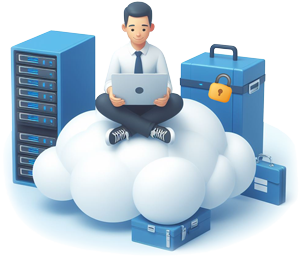Call us on 03333 11 00 66
 On Premises vs Cloud Hosting
On Premises vs Cloud Hosting
Which is right for you?
This is a question that many businesses are asking - With the increasing popularity and availability of cloud services, businesses are being tempted to retire their on-premises hardware in favour of a completely cloud hosted server solution. As with most things, there are benefits and drawbacks which must be considered.
On-Premises Computing
The 'traditional' setup - Businesses have servers on-site in dedicated server rooms, or hidden away in an office - and data is kept on-site. Hardware is typically refreshed every 5-7 years, with migrations to the most recent server software taken into account. Typically managed and maintained by the IT staff, or outsourced to local IT consultancy firms, depending on the size of business.
Benefits of on-premises computing:
- Data Control and Protection in On-Site Setups: On-site configurations empower businesses to manage their data and security protocols directly. This is particularly crucial for companies that need to adhere to stringent regulations or handle sensitive data. By storing their data within their own physical environment, organizations can implement and modify security measures to meet their specific requirements.
- Consistent Performance and Rapid Data Access: On-premises solutions provide businesses with direct control over their hardware and network configurations, resulting in predictable performance.
- Adaptable and Flexible On-Site Infrastructure: Businesses can tailor their on-site infrastructure to suit their specific needs. This includes the selection of hardware components, networking equipment, and software solutions that align with their requirements. Such customization can enhance speed and optimize resource utilization.
Drawbacks of on-premises computing:
- Substantial Initial Costs and Capital Expenditures: Establishing an on-premises system necessitates a significant initial financial outlay. Organizations are required to invest in tools, networking equipment, and other system components. This investment can be costly, particularly for small businesses or those with limited resources.
- Limited Scalability and Risk of Overprovisioning: On-premises setups may struggle to scale substantially when there is a rapid increase in resource demand. Organizations must accurately forecast their future needs. Overestimation can lead to surplus resources, while underestimation can result in performance issues.
- Complexities in IT Management and Maintenance: On-premises equipment requires constant management and maintenance. This includes maintaining the hardware in optimal condition, updating software, applying security patches, and troubleshooting issues. Organizations require skilled IT personnel to perform these tasks, which can increase business costs and resource consumption.
Cloud Computing
Tasks that were once hosted on-site are migrated to off-site datacenters, removing the need for on-site servers, or server rooms. The responsibility of maintaining and upgrading the hardware becomes the responsibility of the cloud vendor (unless the servers are co-located and still belong to the business). Up-front solution expenditure is replaced with a flexible pay-as-you-use subscription model. Cloud hardware are either shared amongst subscribers (public cloud) or dedicated to your business (private cloud).
Benefits of cloud computing:
- Economical and Adaptable Pricing: Cloud computing provides a smart approach to cost management, as you only pay for the resources you use. This model eliminates the need for substantial initial hardware investments. The pay-as-you-go structure allows for flexible scaling of resources, effectively managing expenses.
- Effortless Scaling and Flexibility: The scalability of cloud services is transformative. You can swiftly modify your resources to meet demand, preventing unnecessary overprovisioning. This adaptability is advantageous during peak periods or periods of rapid growth.
- Worldwide Access and Teamwork: Cloud services can be accessed from any location with internet connectivity. This facilitates remote working and seamless collaboration across various locations, aligning with contemporary business practices.
Drawbacks of cloud computing:
- Considerations for Security and Privacy: The act of entrusting sensitive data to the cloud brings about legitimate security and privacy concerns. Despite robust security measures in place by cloud providers, trust in them is still necessary. Compliance with industry standards and regulations is crucial in managing these risks.
- Dependence on Internet Connectivity and Risk of Downtime: Cloud services are dependent on Internet connectivity. Operations can come to a standstill if there's a disruption in your connection or if the cloud provider experiences downtime. This highlights the importance of having contingency plans and ensuring uninterrupted access.
- Compliance Navigation in a Global Setting: Data stored in the cloud may be subject to the laws of the countries where the cloud provider has operations. This can introduce complexities, particularly when data is spread across various regions with different legal stipulations.
Hybrid Cloud - The best of both
By utilising a mixture of on-premises infrastructure and cloud services with a solution tailored to your business needs, you can have a solution that maximises the benefits from both whilst mitigating most of the drawbacks. For example, non-sensitive data can be hosted in the public cloud, sensitive data can be kept on-prem, and your mission critical business apps can be completely contained in your private cloud. There is no 'one size fits all' solution for businesses. We know that all businesses are different and have different expectations and requirements on their data and compute needs.
To discuss your requirements and get a quote, speak to ustoday on 03333 11 00 66




Stay up to date with the latest news + promotions: